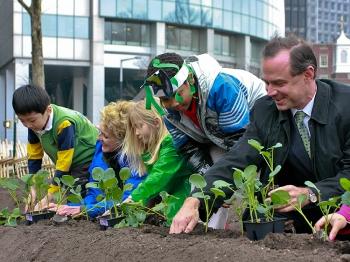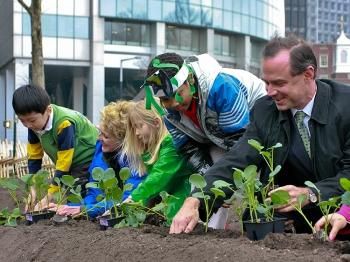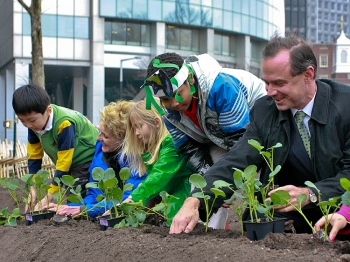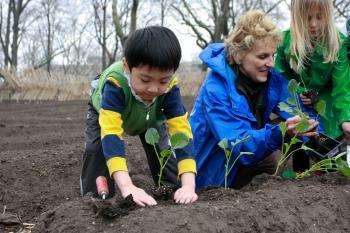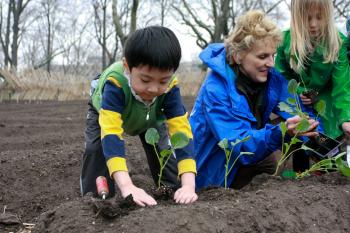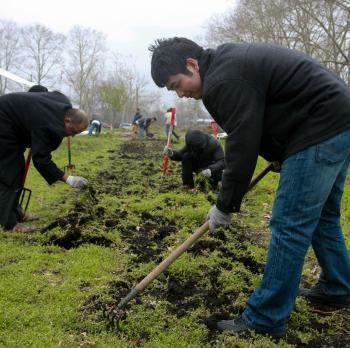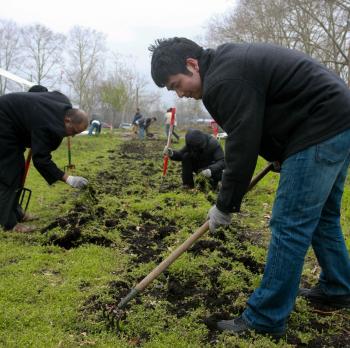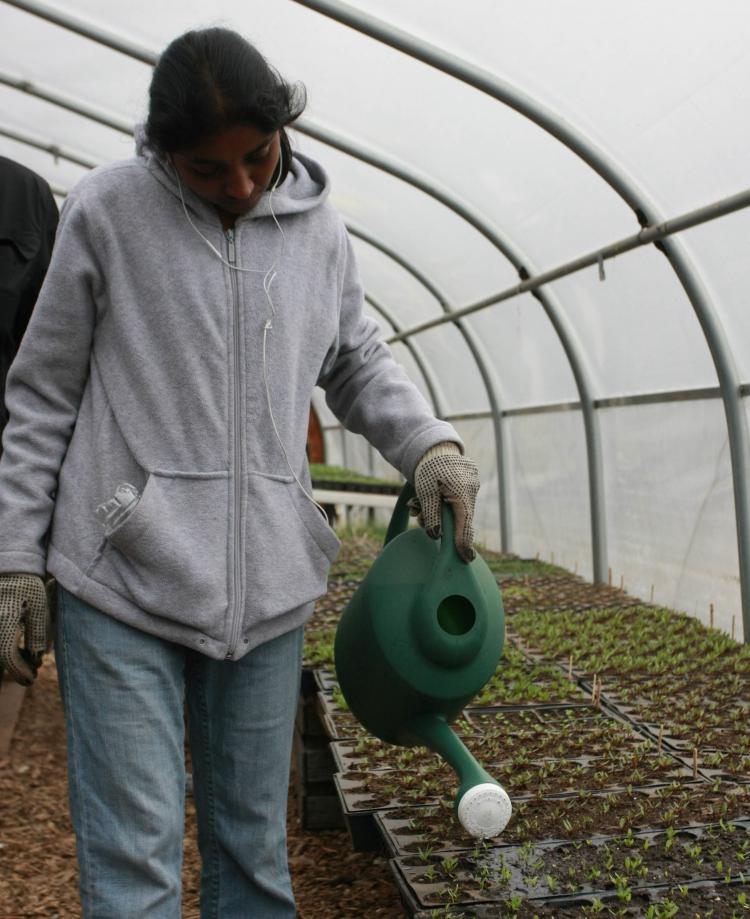NEW YORK—As Earth Day approaches and New Yorkers contemplate their place in the natural order of things, the cycle of food production and consumption is a good place to start.
Urban farming is no longer an oxymoron. Across the five boroughs, approximately 600 gardens are protected by the Department of Parks and Recreation’s GreenThumb division; 55 are protected by the New York Restoration Project; and hundreds of others fill spaces between buildings and create fresh produce for local residents.
Local politicians and gardeners alike tout the growing movement as a solution to obesity and diabetes, a community-building institution, a way to educate children, a way to feed the city without burning fossil fuel on transport, and even a moneymaking enterprise.
Red Hook Community Farm in Brooklyn sold $53,000 worth of produce from its 2.75-acre lot last year. The youth-run initiative started in 2003 and brings needed nutrition to one of the city’s “food deserts,” and empowers local youth.
Over 100 volunteers worked in the rain on Saturday to pull weeds, till the soil, and prepare the seeds for a prosperous season. Ian Marvey bent down to pick a strawberry leaf and rub it against his teeth.
“The Dakota [Native Americans] used to use these to brush their teeth,” Marvey told a teenaged volunteer. The gardening experience allows Brooklyn youth to reconnect with the land and with the history of New York City.
Urban farming is no longer an oxymoron. Across the five boroughs, approximately 600 gardens are protected by the Department of Parks and Recreation’s GreenThumb division; 55 are protected by the New York Restoration Project; and hundreds of others fill spaces between buildings and create fresh produce for local residents.
Local politicians and gardeners alike tout the growing movement as a solution to obesity and diabetes, a community-building institution, a way to educate children, a way to feed the city without burning fossil fuel on transport, and even a moneymaking enterprise.
Red Hook Community Farm in Brooklyn sold $53,000 worth of produce from its 2.75-acre lot last year. The youth-run initiative started in 2003 and brings needed nutrition to one of the city’s “food deserts,” and empowers local youth.
Over 100 volunteers worked in the rain on Saturday to pull weeds, till the soil, and prepare the seeds for a prosperous season. Ian Marvey bent down to pick a strawberry leaf and rub it against his teeth.
“The Dakota [Native Americans] used to use these to brush their teeth,” Marvey told a teenaged volunteer. The gardening experience allows Brooklyn youth to reconnect with the land and with the history of New York City.
Growing with the Times
The Lenape Native Americans, later known as the Dakotas, who first inhabited Manhattan were small-scale farmers. Their practices were foreign to European settlers who planted their crops on a much larger scale.
The Lenape women tended the garden while the men hunted and fished. In Europe, hunting and fishing were sports enjoyed by nobility—leisure activities.
“Almost invariably, all the European writers say, ‘The Indian men are the laziest creatures you’ve ever seen! They go off enjoying themselves hunting and fishing all day and leave the women stuck with all the work at home,” explains Dr. David Oestreicher, an expert on the Lenape people, with a laugh.
As the city developed, farming was moved to larger plots upstate, as was the European way. Around the turn of the 20th century, however, some city dwellers realized that getting your hands dirty is a lot of fun.
The term locavore may have been coined in recent years, and maybe New Yorkers of yore never heard of “going green,” but urban farming is not a new idea.
In 1902, the city’s first urban farm was established in De Witt Clinton Park on the west side of Manhattan on 52nd Street. The pioneer lady behind the rake and hoe was Mrs. Henry G. Parsons. She created a three-quarter of an acre outdoor classroom. Several others popped up around town, and by 1918, 3,565 little farmers were bringing in a yield of produce worth $4 each.
The Lenape women tended the garden while the men hunted and fished. In Europe, hunting and fishing were sports enjoyed by nobility—leisure activities.
“Almost invariably, all the European writers say, ‘The Indian men are the laziest creatures you’ve ever seen! They go off enjoying themselves hunting and fishing all day and leave the women stuck with all the work at home,” explains Dr. David Oestreicher, an expert on the Lenape people, with a laugh.
As the city developed, farming was moved to larger plots upstate, as was the European way. Around the turn of the 20th century, however, some city dwellers realized that getting your hands dirty is a lot of fun.
The term locavore may have been coined in recent years, and maybe New Yorkers of yore never heard of “going green,” but urban farming is not a new idea.
In 1902, the city’s first urban farm was established in De Witt Clinton Park on the west side of Manhattan on 52nd Street. The pioneer lady behind the rake and hoe was Mrs. Henry G. Parsons. She created a three-quarter of an acre outdoor classroom. Several others popped up around town, and by 1918, 3,565 little farmers were bringing in a yield of produce worth $4 each.
Then-Parks Commissioner William R. Willcox noted, “Older persons who live thereabout declare they can see a decided difference in the courtesy and general conduct of the youngsters since the plan was first adopted.” Indeed, the young men and women at Red Hook Community Farm today carry themselves with an air of confidence and express a down-to-earth pride in the hard work they do on the farm.
The De Witt Clinton garden prospered until the West Side Highway ran through it in 1932.
Another lady pioneer took up the urban gardening cause in the 1970s—Liz Christy. She would toss “seed bombs” onto abandoned lots and go on stealth missions to fertilize public plots, all in the days before urban gardening was permitted in New York City’s vacant spaces. Christy founded the Green Guerillas.
“They took the warring term of ‘guerrillas’ and turned it around,” says Ross Martin, executive director of La Plaza Cultural, a community garden in the lower East Side. Mayor Ed Koch legitimized the Guerillas, allowing them to keep up the public land of their own volition and from their own resources.
Read More...At the Mercy of the Powers That Be
The De Witt Clinton garden prospered until the West Side Highway ran through it in 1932.
Another lady pioneer took up the urban gardening cause in the 1970s—Liz Christy. She would toss “seed bombs” onto abandoned lots and go on stealth missions to fertilize public plots, all in the days before urban gardening was permitted in New York City’s vacant spaces. Christy founded the Green Guerillas.
“They took the warring term of ‘guerrillas’ and turned it around,” says Ross Martin, executive director of La Plaza Cultural, a community garden in the lower East Side. Mayor Ed Koch legitimized the Guerillas, allowing them to keep up the public land of their own volition and from their own resources.
Read More...At the Mercy of the Powers That Be
At the Mercy of the Powers That Be
Farming in the country is an uncertain business; months of hard work can be swept away in drought, pestilence, scavenging moles, or rabbits. The city’s farmers have to worry more about scavenging New Yorkers than rodents; in addition to being at the mercy of the elements, New York’s urban farmers are at the mercy of city planning and development.
On the New York City Park Advocates blog, A Walk in the Park , Jennifer Riveraton recounts the tale of one garden lost in the flurry of development. In 2002, Hostos-Crimmins Garden in Mott Haven, South Bronx, was bulldozed to make way for five town homes.
“We agree that Mott Haven needs new affordable housing. However, there are hundreds of ugly abandoned lots around here. Why destroy our garden? We already had to move the garden once before: We are tired of rebuilding,” wrote the gardeners in a plea to South Bronx Churches (SBC), an organization that supported the development as a way to bring affordable housing to its parishioners.
The Hostos-Crimmins Garden was patched together by many hands, local residents who donated parcels of time when they could spare it. Riveraton quotes a local resident’s description of the garden:
“They decorated the garden using the same method of spare time, spare materials, and random whimsy to create a beautiful and intricate work of art. A peach tree provides shade for a cement pool of water surrounded by half a dozen statues of the Virgin Mary and several statues of Jesus. The gardeners were very proud of the fact that ducks often visited their pond. A couple of chickens ran loose, never tempted to leave their green oasis. A picket fence was painted in bright red, blue, and yellow—the three colors alternating between each board.”
The loss of this reprieve from the hostile environment that surrounded it is not an isolated case.
“There are no permanent protections [for urban farms],” points out Geoffrey Croft of NYC Park Advocates.
The city announced in November 2010 that all active gardens will be guaranteed protection for four years, but gardeners are calling for greater insurance.
The movement has come a long way in a few decades, with greater gains to be hoped for as the green awareness spreads. Urban gardeners have a voice in City Council, with Speaker Christine Quinn and Councilwoman Melissa Mark-Viverito being among some of the most adamant advocates for a locally sustained food economy.
With greater awareness comes greater demand for locally grown food, and many of the city’s restaurants are sourcing from urban crops, or creating their own stock in rooftop gardens.
On the New York City Park Advocates blog, A Walk in the Park , Jennifer Riveraton recounts the tale of one garden lost in the flurry of development. In 2002, Hostos-Crimmins Garden in Mott Haven, South Bronx, was bulldozed to make way for five town homes.
“We agree that Mott Haven needs new affordable housing. However, there are hundreds of ugly abandoned lots around here. Why destroy our garden? We already had to move the garden once before: We are tired of rebuilding,” wrote the gardeners in a plea to South Bronx Churches (SBC), an organization that supported the development as a way to bring affordable housing to its parishioners.
The Hostos-Crimmins Garden was patched together by many hands, local residents who donated parcels of time when they could spare it. Riveraton quotes a local resident’s description of the garden:
“They decorated the garden using the same method of spare time, spare materials, and random whimsy to create a beautiful and intricate work of art. A peach tree provides shade for a cement pool of water surrounded by half a dozen statues of the Virgin Mary and several statues of Jesus. The gardeners were very proud of the fact that ducks often visited their pond. A couple of chickens ran loose, never tempted to leave their green oasis. A picket fence was painted in bright red, blue, and yellow—the three colors alternating between each board.”
The loss of this reprieve from the hostile environment that surrounded it is not an isolated case.
“There are no permanent protections [for urban farms],” points out Geoffrey Croft of NYC Park Advocates.
The city announced in November 2010 that all active gardens will be guaranteed protection for four years, but gardeners are calling for greater insurance.
The movement has come a long way in a few decades, with greater gains to be hoped for as the green awareness spreads. Urban gardeners have a voice in City Council, with Speaker Christine Quinn and Councilwoman Melissa Mark-Viverito being among some of the most adamant advocates for a locally sustained food economy.
With greater awareness comes greater demand for locally grown food, and many of the city’s restaurants are sourcing from urban crops, or creating their own stock in rooftop gardens.
